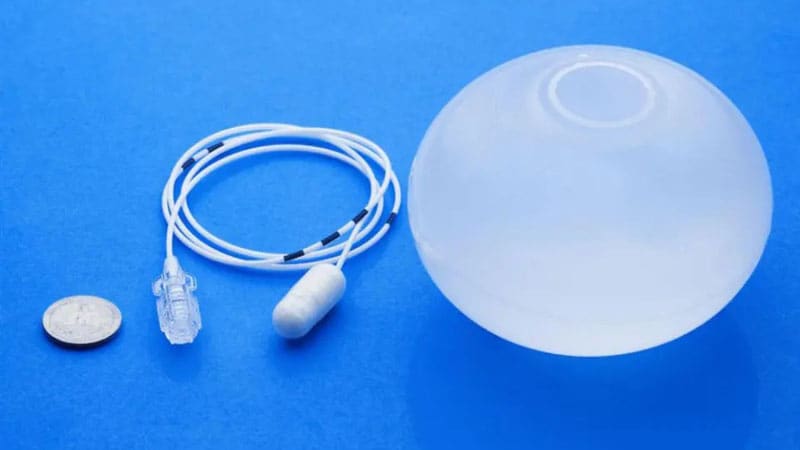Swallowable Intragastric Balloon Shows Significant Weight Loss
The Allurion intragastric balloon (formerly the Elipse, Allurion Technologies), a novel balloon that is swallowed, requiring no surgery or endoscopic placement, shows high efficacy in achieving weight loss and an improved metabolic profile, with fewer adverse events than reported with other available gastric balloons, results from a meta-analysis show.
“We believe this analysis to be the most comprehensive review [of the Allurion balloon],” reports first author Daryl Ramai, MD, of the Division of Gastroenterology and Hepatology, University of Utah School of Medicine, Salt Lake City, and colleagues in the research published in the November/December 2021 issue of the Journal of Clinical Gastroenterology.
“Our study showed that the Allurion balloon reduces waist circumference and triglyceride levels and [is] associated with less adverse events when compared with other intragastric balloons,” the authors conclude.
Unlike other balloons, the Allurion gastric balloon is compressed into a small capsule that is connected to a thin catheter and, once swallowed, it is then inflated with 550 mL of liquid through the catheter to create a feeling of fullness and help control hunger.
The procedure can be performed on an outpatient basis in approximately 20 minutes, potentially avoiding the burden and extra costs of surgery or endoscopic placement and removal. After approximately 4 months, the balloon is designed to empty through a valve that spontaneously opens, and the balloon is then passed in the stool.
Though currently used around the world, the balloon does not yet have approval from the US Food and Drug Administration (FDA).
Meta-Analysis Shows 12.2% Average Weight Loss Across Studies
To assess the balloon’s performance, the authors identified seven out of 273 published studies that met the analysis criteria. The studies included 2152 patients, ranging in age from 18 to 65 years, with a mean baseline body mass index (BMI) of 32.1 to 38.6 kg/m2.
All of the studies were prospective, with reported outcomes at 3 to 4 months, when the Allurion balloon typically deflates. Three of the studies were multicenter, while four were single-center.
In terms of improvements in BMI, the results showed the pooled mean difference from baseline through to the end of the studies was 0.88 (P = .001), and the weighted average percentage of total body weight loss during treatment across the studies was 12.2%.
The mean excess body weight loss across the Allurion studies was 49.1%.
The analysis was not designed to directly compare outcomes with other balloons, but the authors note, for instance, that the ReShape Duo intragastric balloon (an FDA-approved dual-balloon system) has been reported in a previous study to have a percentage of total body weight loss of 7.6% at 6 months, compared with 3.6% observed among those who received lifestyle modifications.
However, a separate meta-analysis showed the pooled percentage of total body weight loss with the FDA-approved Orbera balloon to be about the same as the current Allurion analysis, at 12.3% at 3 months after implantation (followed by 13.2% at 6 months and 11.3% at 12 months).
That analysis further showed excess body weight loss with the Orbera balloon at 12 months to be 25.4%.
In other outcomes, the current meta-analysis also showed significant improvements with the Allurion balloon in waist circumference of 0.89 (P = .001) and in triglyceride levels of 0.66 (P = .004) versus baseline.
Previous research involving the FDA-approved Obalon intragastric balloon, which is inflated with gas rather than liquid, showed a reduction in waist circumference from 109 cm (±12.3) to 99 cm (±10.5; P < .05), and another study showed that 37.5% of patients receiving the Orbera balloon had normalized triglyceride levels after 4 months, without concomitant medical therapy.
Adverse Events Appear Lower vs Other Balloons
Potential risks associated with the Allurion balloon include the potential for early deflation; however, the pooled rate of early balloon deflation observed in the meta-analysis was relatively low, at 1.8%.
Other adverse events reported with the Allurion balloon were abdominal pain (37.5%), vomiting (29.6%), diarrhea (15.4%), and small bowel obstruction (0.5%).
The corresponding rates of abdominal pain with the ReShape Duo and Orbera balloons have been reported at 54.5% and 57.5%, respectively, with the effects possibly due to overinflation, the authors note.
And rates of vomiting with the ReShape Duo and Orbera balloons have been reported as much higher, at 86.7% and 86.8%, respectively.
Of note, there were no deaths or cases of acute pancreatitis reported in the meta-analysis studies of Allurion.
As reported by Medscape Medical News, such concerns have been raised in previous FDA alerts regarding the Orbera and ReShape Duo liquid-filled intragastric balloons.
In the most recent update , issued in April 2020, the FDA described receiving reports of 18 deaths that had occurred worldwide since the approvals of the Orbera and ReShape balloons, including eight in the United States.
First author Ramai noted that the concern about the issues is warranted.
“These concerns are valid,” he told Medscape Medical News. “Theoretically, since the Allurion balloon is placed for a shorter time span, it is conceivable that there may be less adverse events. However, comparative trials are needed to confirm this.”
While the balloons show efficacy in patients struggling with weight loss, metabolic syndrome and fatty liver disease, “the type and duration of intragastric balloons should be tailored to the patient,” Ramai said.
“Clinicians should thoroughly discuss with their patients the benefits and risks of using an intragastric balloon,” he added. “Furthermore, placement of intragastric balloons should only be attempted by clinicians with expertise in bariatric endoscopy.”
The study received no financial support. Ramai has reported no relevant financial relationships.
J Clin Gastroenterol. 2021;55:836-841. Abstract
For more diabetes and endocrinology news, follow us on Twitter and Facebook.
Follow Medscape on Facebook, Twitter, Instagram, and YouTube.
Source: Read Full Article
